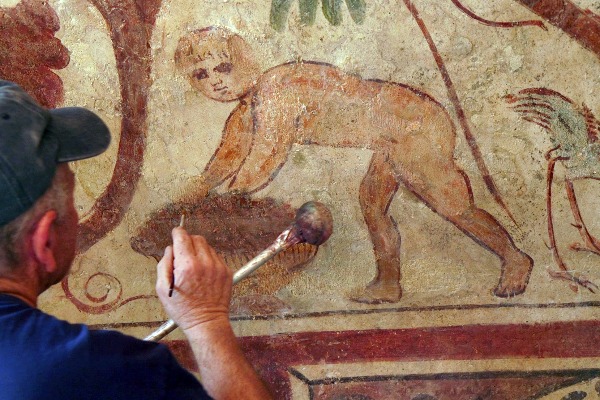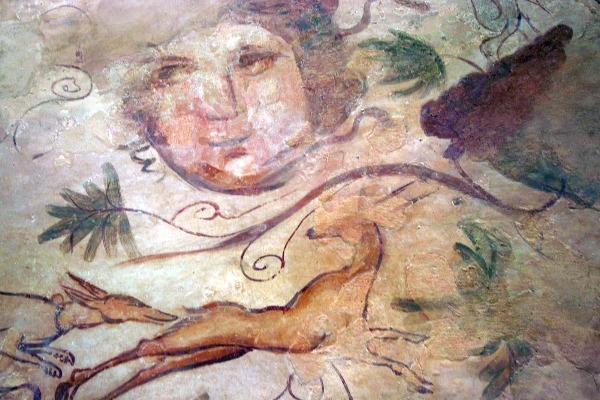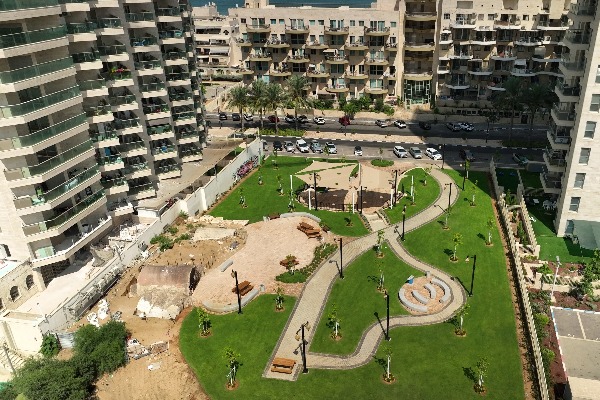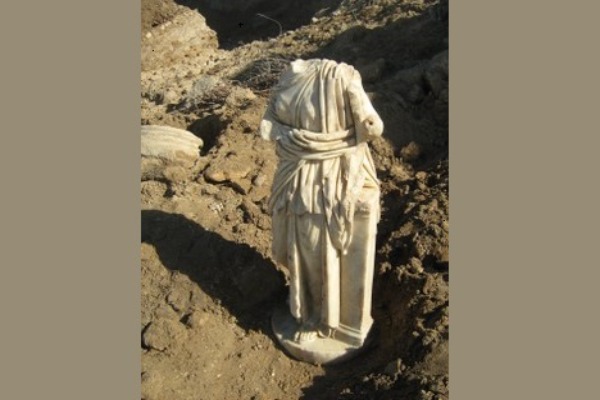Magnificent wall paintings in ancient Roman tombs set to be unveiled in city of Ashkelon
Beautiful paintings were discovered decades ago but remained unseen by public

The city of Ashkelon is set to unveil two ancient vaulted tombs, over 1,700 years old, featuring rare and magnificent Roman wall paintings of Greek mythological figures, humans, plants and animals.
These ancient beautiful paintings, adorning the tombs of wealthy Roman families, were discovered decades ago but have since remained largely unseen by the public.

This marks a significant achievement in the ongoing collaboration between the Ashkelon Municipality and the Israel Antiquities Authority (IAA), aimed at integrating the city's rich historical heritage into public spaces for the benefit of both residents and tourists.
Discovered in the 1930s, some 300 meters from the beach, the first tomb dates to the early 4th century A.D. and was initially excavated during a British expedition. The tomb comprises a hall with four adjacent burial troughs, adorned with an array of impressive wall paintings.
Among the depictions are Demeter, the Greek goddess of earth and grain; vines and grape clusters; various leaves and branches; and mythological nymphs crowned with lotus wreaths, pouring water from pitchers.
Additionally, the artwork includes representations of children gathering grapes, birds, deer, a figure playing Pan’s flute, and the iconic head of Medusa, the mythological Gorgon whose gaze could turn onlookers to stone.
In contrast, the second tomb, relocated to the current public garden in the 1990s from another site in the southern city, dates back to the 2nd century A.D.
Excavated by Dr. Elena Kogan-Zehavi of the IAA, this tomb features a central hall with vibrant paintings of human figures, birds, and other elements of the natural world. Vaulted loculi surround the hall, which contains lead coffins decorated with images of humans, animals and vegetation.

In recent months, a team of experts from the IAA worked to preserve these tombs and their intricate decorations, and prepared them for the big public unveiling.

Mark Abrahami, head of the IAA's art conservation branch, noted: "Ancient wall paintings are usually not preserved in Israel’s humid climate. As the paintings were in a relatively closed structure it protected them, to some extent, for decades. Naturally, exposure of the centuries-old paint to air and moisture caused fading and weathering. We had to conduct a long and sensitive process to stop and repair the ravages of time and weathering."

Ashkelon Mayor Tomer Glam emphasized the importance of preserving the city's ancient history alongside its development
"Ashkelon is one of the world’s oldest cities, and as we shape and design the city's future, we ensure a place of honor to its glorious and rich past. In recent years we have made a real revolution in the realm of historical site preservation. We made sites accessible to the city's residents and to the general public."

In addition to the tombs, the Ashkelon Municipality has invested significantly in the development and preservation of other ancient sites within the city. This includes the creation of a large public park in the new Wine City neighborhood, centered around an ancient industrial site with winepresses, olive presses, warehouses, and a bathhouse. Other initiatives include the conservation of a mosaic on Yekutiel Adam Street, located next to a playground that uniquely incorporates archaeological elements, and the enhancement of the sarcophagus courtyard, a public display of numerous rare artifacts found across the city.
The sarcophagus courtyard serves as a museum-like complex and showcases artifacts, primarily from the Roman and Byzantine periods, unearthed in Ashkelon. Among the most significant exhibits are two sarcophagi from the 4th century A.D., discovered in 1972, which lend the site its nickname. These sarcophagi are adorned with highly artistic depictions of scenes from Greek and Roman mythology, symbolizing the wealth and significance of Ashkelon during the Roman era.
Another relatively recent find that underscores Ashkelon's rich archaeological history is an artifact that was discovered in a quite unusual location. About 14 years ago, a passerby on Ashkelon's beach discovered a Roman-era statue of a woman, estimated to be 1,800-2,000 years old. The Israel Antiquities Authority retrieved this 1.2-meter-tall marble statue from the beach's sandy cliffs. The statue, missing its head and hands, had fallen into the water due to coastal erosion during a storm.

Eli Escusido, director of the IAA, praised Ashkelon’s efforts, stating: "The city of Ashkelon is one of the first cities in Israel that are wisely acting to leverage the enormous potential in values and aesthetics embodied within its heritage assets. Ashkelon is an example of how the integration of ancient findings into the urban fabric can occur, in collaboration with the IAA, in a manner that imparts additional worth to and provokes interest in its public spaces."
The public garden, soon to be opened for the upcoming Jewish holidays, will allow Ashkelon residents, Israeli visitors and tourists, to marvel at these rare and beautiful paintings, offering a unique opportunity to connect with the rich and fascinating history of this vibrant city.

The All Israel News Staff is a team of journalists in Israel.
You might also like to read this:














